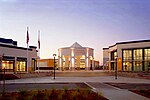Los Vaqueros Reservoir
1998 establishments in CaliforniaDiablo RangeProtected areas of Contra Costa County, CaliforniaReservoirs in Contra Costa County, CaliforniaReservoirs in Northern California

The Los Vaqueros Reservoir and watershed is located in the northern Diablo Range, within northeastern Contra Costa County, northern California. It was completed by the Contra Costa Water District (CCWD) in 1998 (1998) to improve the quality of drinking water for its 550,000 customers in Central and Eastern Contra Costa County. The reservoir is accessible via Vasco Road, a road which connects Brentwood and Livermore. Some 20,000 acres of land was acquired to provide for construction of the dam and its 1500-acre reservoir, as well as protection of 19,300 acres of associated watershed.
Excerpt from the Wikipedia article Los Vaqueros Reservoir (License: CC BY-SA 3.0, Authors, Images).Los Vaqueros Reservoir
Geographical coordinates (GPS) Address Nearby Places Show on map
Geographical coordinates (GPS)
| Latitude | Longitude |
|---|---|
| N 37.82025 ° | E -121.7338 ° |
Address
Contra Costa County (Contra Costa)
California, United States
Open on Google Maps




